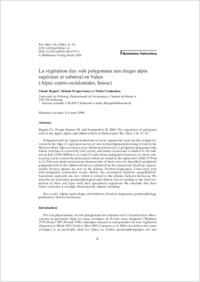La végétation des sols polygonaux aux étages alpin supérieur et subnival en Valais (Alpes centro-occidentales, Suisse)
- Béguin, Claude Département de Géosciences, Université de Fribourg, Switzerland - Chaumont CH-2067, Switzerland
- Progin Sonney, Mélanie Département de Géosciences, Université de Fribourg, Switzerland
- Vonlanthen, Michel Département de Géosciences, Université de Fribourg, Switzerland
-
23.06.2006
Published in:
- Botanica Helvetica. - 2006, vol. 116, p. 41-54
English
Polygonal soils are typical formations of arctic regions but occur locally at high elevation in the Alps. A vegetation survey of sites with polygonal patterning of soils in the Western Swiss Alps revealed a clear distinction between (1) periglacial polygonal soils, whose structure is created by frost action, and whose occurrence is limited to the subniveal belt (2700–3000 m a.s.l.) and (2) soils whose polygonal structures are mere contraction cracks created by desiccation, which are found in the alpine belt (2300–2750 m a.s.l). Two new plant associations characteristic of these sites are described: periglacial polygonal soils of the subniveal belt are colonized by the association Saxifrago oppositifoliae- Poetum alpinae ass. nov. of the alliance Drabion hoppeanae. Conversely, soils with polygonal contraction cracks shelter the association Epilobio anagallidifolii- Saginetum saginoidis ass. nov., which is related to the alliance Salicion herbaceae. We describe the particular geomorphological and climatic factors leading to the local formation of these soil types with their specialised vegetation. We conclude that their future existence is strongly threatened by climate warming.
- Faculty
- Faculté des sciences et de médecine
- Department
- Département de Géosciences
- Language
-
- French
- Classification
- Botany
- License
-
License undefined
- Identifiers
-
- RERO DOC 6058
- DOI 10.1007/s00035-006-0737-z
- Persistent URL
- https://folia.unifr.ch/unifr/documents/300059
Statistics
Document views: 147
File downloads:
- Fichier principal: 235
